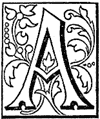| Home -> John J. Newbegin -> Little Literary Lights - Art | |||
|
Art
 Art doesn't mean much unless you have a love and appreciation for it. A noted French author has defined it as "Nature viewed through a temperament"; it is a clairvoyant knowledge that cannot be easily acquired by education, the spirit of it may be cultivated a little but it must be inborn. Art, in itself, is the applied residue of meditation, contemplation and inspiration embodied in ideal settings. The story is told of Whistler who, upon hearing a critic state that he could see nothing in a certain picture, replied, "I feel sorry for him." Art doesn't mean much unless you have a love and appreciation for it. A noted French author has defined it as "Nature viewed through a temperament"; it is a clairvoyant knowledge that cannot be easily acquired by education, the spirit of it may be cultivated a little but it must be inborn. Art, in itself, is the applied residue of meditation, contemplation and inspiration embodied in ideal settings. The story is told of Whistler who, upon hearing a critic state that he could see nothing in a certain picture, replied, "I feel sorry for him."What memories the very word art revives of studios - ateliers - earnest and ambitious and, at the same time, free and careless Bohemian men and women - rich colorings - imaginative drawings - soul-stirring effects - impressionist dreams - soft tones! and struggling efforts to depict inspirations - galleries, old masters and modern exhibitions, - all recall interesting hours and happy days, spent in a congenial atmosphere! The highest art is for the initiated alone; it is only pictures that appeal to the public taste. The frothy drawing with simply a "story" and one with something beyond is the principal difference between a picture and art. The picture, that imitates or exhibits the mere externals of life, is the product of a painter and readily comprehended, but of which you soon grow tired and cast aside, while the work of art with an original conception that expresses something, the composition of an artist with creative instinct, you can live with and constantly read into it new meanings, for its pulse beats carry many messages for the receptive. Art, in its many phases, has no effect upon those who fail to understand it and no attraction for those without sentiment. Many people pass a meagre, empty existence, indifferent to everything that does not affect their bare subsistence. One must, indeed, be a lover of nature, with its speculative promises, possibilities and contemplative, superhuman inspirations, to love art. I admire the free, impressive work full of suggestion, with the poetic element predominant, giving the imagination full play - say color and suggestion rather than detail. The idealistic tinge pleases me more strongly than realism with its narrow horizon, which is usually either stereotyped or eccentric. A man of talent can portray in paint a suggestion of the wonderful hidden secrets of nature, vitalizing their spiritual and sensuous values and forms - such canvases need no interpreter and are perfectly plain to kindred spirits having an affinity for the beautiful, who fully understand their poetry; on the other hand, conventional scenes, even though true copies of life, do not appeal to one - they reveal nothing. Their etched subjects lack the rich quality of mystery so dear to the mature Cult with sensitive organisms and deep intuition. It is the sense of imagery, the elevating instinct of light, the romance of symbolism expressed in shading, outlines and resplendent color of the sensitive dreamers that awaken delicious thoughts of interpretation, whose transition is felt rather than known or seen, and arouse the better feelings of the inner self. True artists with essential molding force and inspired with a purpose, in the personal treatment from their point of view, express the best part of themselves in productions of this kind, using their lines rather in a subsidiary way to convey their real meaning and present a prophetic vision, radiating sparks of light, that appeals to the imagination and reaches a responsive chord that lulls our souls and harmonizes with our spiritual meditations, a reflection, making one forget in the process, drawing, paint and individual and losing oneself, without noting the line of demarcation, in the poetic mystery of color depicted on the canvas; theirs is a material recital of impressions that utter our wistful fancies. In this ethereal mood, one is thrilled with feelings of satisfaction, rest and gratitude. It is, unfortunately, however, a language that speaks in accents of its own, understood by the few and resented by the many who neither see, feel nor understand the intent of the artist. The idea has been beautifully expressed in a Chinese lyric by Pai Ta-Shun, a translation of which is as follows: I would not paint a face
|
|||